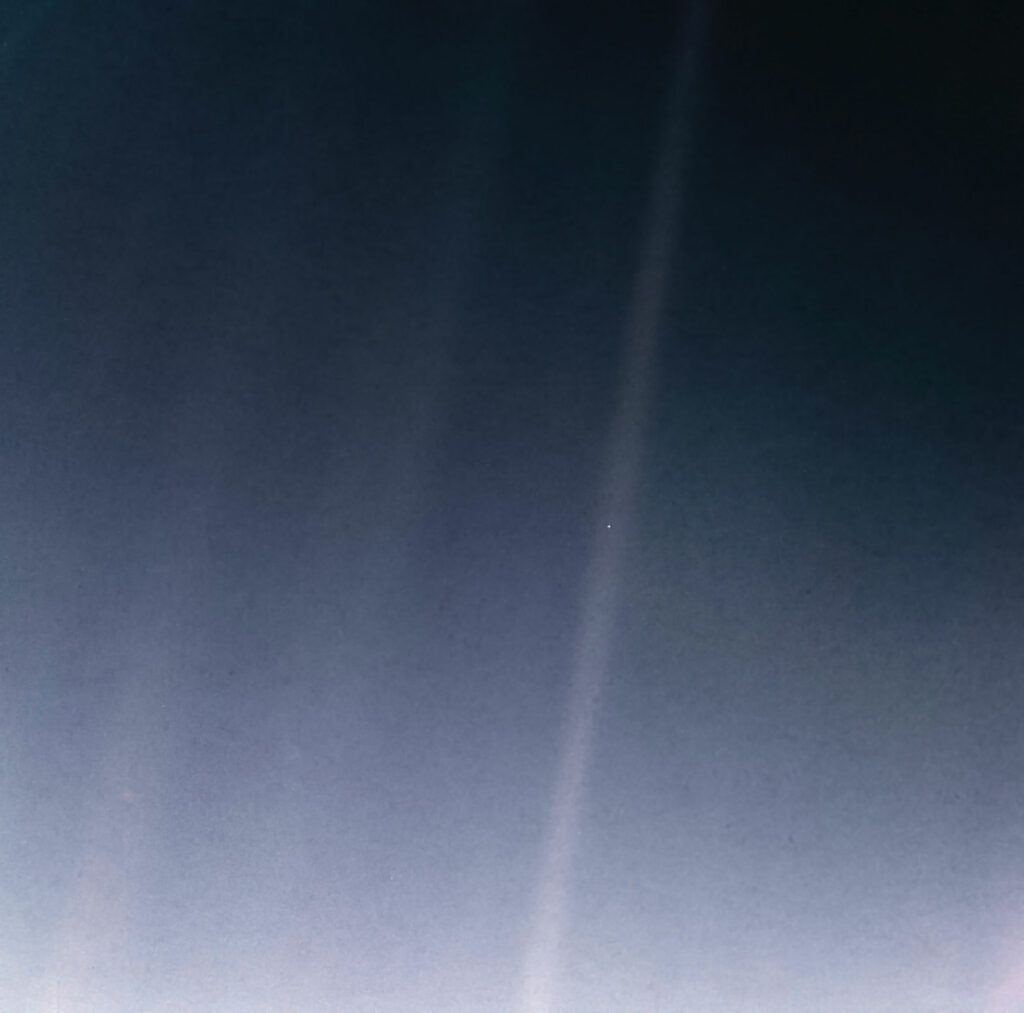Iconic Pale Blue Dot image turns 35
Looking back
Today’s a special day, the image that inspired the name of our studio turn 35. It was Valentine’s day in 1990 when the famous image was first published by NASA.
Our Name: A Tribute to Perspective and Wonder
At Pale Blue Dot Studio, the inspiration behind our name is deeply intertwined with a momentous piece of human history and a profound reflection on our place in the universe. Our name pays homage to the iconic “Pale Blue Dot” photograph taken by NASA’s Voyager 1 spacecraft and the impactful message it conveys, immortalized in the words of the renowned astronomer and author, Carl Sagan.

The Iconic Image: A Vision from the Voyager
The “Pale Blue Dot” image holds the distinction of being captured from the farthest distance ever by a human-made object from Earth. In 1990, as Voyager 1 was leaving our planetary neighborhood, Carl Sagan, who was a member of the mission’s imaging team, proposed an idea: to turn the spacecraft around to photograph Earth from billions of miles away. The resulting image, although tiny in the frame, was monumental in its implications. It showed Earth as a speck, less than a pixel in size, suspended in the vastness of space.
Embracing Fragility and Unity
This photograph, while highlighting the sheer vastness of space, also beautifully encapsulates the fragility and uniqueness of our planet. It serves as a humbling reminder of our small place in the cosmos and the shared home of all human endeavors, joys, and struggles. This perspective is at the core of our photographic philosophy. At Pale Blue Dot Studio, we strive to capture the essence of moments, big and small, with the understanding that each is a part of a larger, intricate tapestry of human experience.
Our Mission: Capturing the Grandeur of the Minuscule
Just as the “Pale Blue Dot” image captures the grandeur of our planet in a single, minuscule speck, we at Pale Blue Dot Studio aim to find and showcase the grand in the seemingly ordinary. Our photography is more than just a visual record; it’s a celebration of the fleeting moments, a capturing of the ephemeral beauty that surrounds us, and a tribute to the shared human experience on our tiny but precious planet.
Carl Sagan, Pale Blue Dot: A Vision of the Human Future in Space
“Look again at that dot. That’s here. That’s home. That’s us. On it everyone you love, everyone you know, everyone you ever heard of, every human being who ever was, lived out their lives. The aggregate of our joy and suffering, thousands of confident religions, ideologies, and economic doctrines, every hunter and forager, every hero and coward, every creator and destroyer of civilization, every king and peasant, every young couple in love, every mother and father, hopeful child, inventor and explorer, every teacher of morals, every corrupt politician, every “superstar,” every “supreme leader,” every saint and sinner in the history of our species lived there-on a mote of dust suspended in a sunbeam.
The Earth is a very small stage in a vast cosmic arena. Think of the endless cruelties visited by the inhabitants of one corner of this pixel on the scarcely distinguishable inhabitants of some other corner, how frequent their misunderstandings, how eager they are to kill one another, how fervent their hatreds. Think of the rivers of blood spilled by all those generals and emperors so that, in glory and triumph, they could become the momentary masters of a fraction of a dot.
Our posturings, our imagined self-importance, the delusion that we have some privileged position in the Universe, are challenged by this point of pale light. Our planet is a lonely speck in the great enveloping cosmic dark. In our obscurity, in all this vastness, there is no hint that help will come from elsewhere to save us from ourselves.
The Earth is the only world known so far to harbor life. There is nowhere else, at least in the near future, to which our species could migrate. Visit, yes. Settle, not yet. Like it or not, for the moment the Earth is where we make our stand.
It has been said that astronomy is a humbling and character-building experience. There is perhaps no better demonstration of the folly of human conceits than this distant image of our tiny world. To me, it underscores our responsibility to deal more kindly with one another, and to preserve and cherish the pale blue dot, the only home we’ve ever known.”

